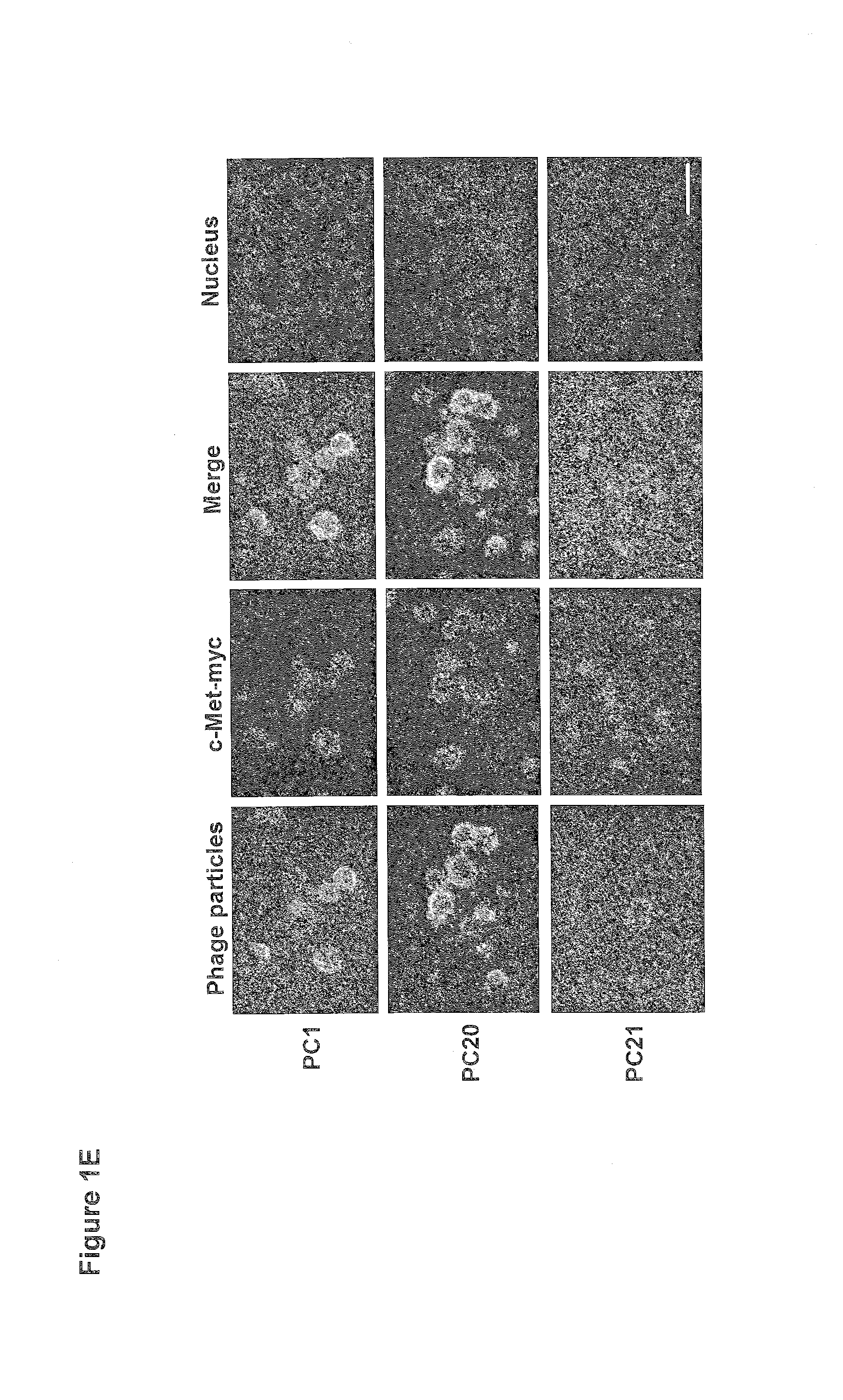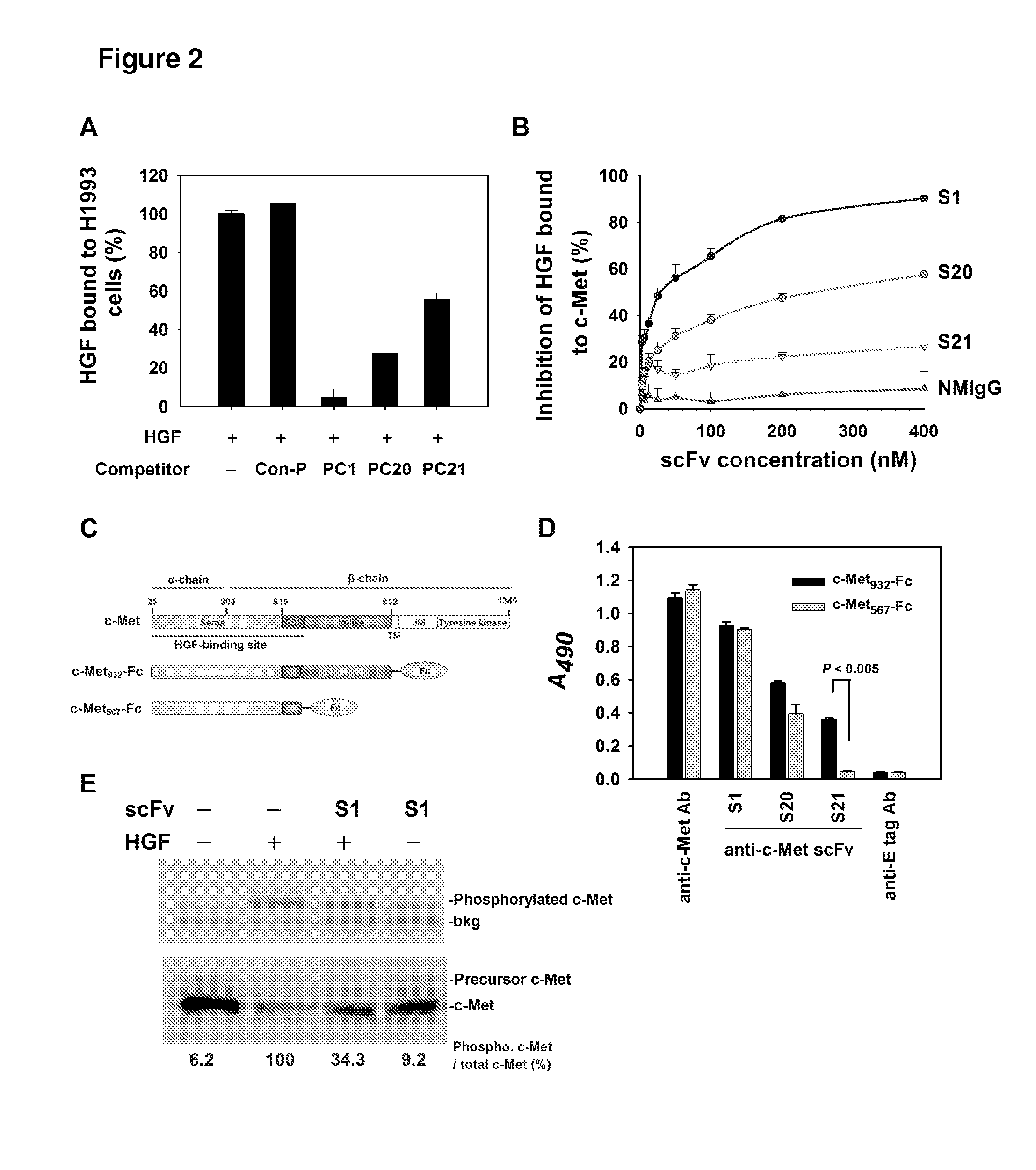Anti-C-Met Antibody and Methods of Use Thereof
- Summary
- Abstract
- Description
- Claims
- Application Information
AI Technical Summary
Benefits of technology
Problems solved by technology
Method used
Image
Examples
example 1
[0199]Identification of Phage-Displayed scFv that Binds to c-Met
[0200]To select a c-Met-binding scFv, phage-displayed human naïve scFv library containing 2×109 members was constructed. Dynabeads-binding phages were first removed from the library before selecting for c-Met-binding phages by c-Met-conjugated Dynabeads. After five rounds of affinity selection, the phage recovery of the fifth round had increased about 1000-fold that of the first round (FIG. 1, panel A). Fifty-nine phage clones were randomly selected and tested for c-Met binding by ELISA. Fourteen phage clones were found to have superior binding activity to c-Met-Fc protein (A490>0.2). Control phage (Con-P) was used as a negative control. Sixteen clones that specifically bound to c-Met were identified, but not to VEGFR2 and BSA control protein (FIG. 1, panel 8). By sequencing all 16 individual clones, three unique anti-c-Met phage clones were identified (PC1, PC20, and PC21). See Table 1 below.
TABLE 1Amino aicd sequences...
example 2
[0205]Anti-c-Met scFvs Bound to Human Cancer and VEGF-Stimulated Endothelial Cells
[0206]The binding activities of anti-c-Met scFvs to endogenous c-Met were analyzed in cancer cells by ELISA (FIG. 9, panel A). Compared to the control antibody, both anti-c-Met S1 and S20 were found to bind to several types of human cancer cell lines, including SKOV3, Mahlavu, SAS, PC3, MDA-MB-231, HCT116, Paca-2, NPC-TW04, H1993 cells. However, the scFvs did not react with A498, U2OS, and NNM cells. Normal mouse IgG was used as a control antibody. FACS analysis was performed to verify that the Both anti-c-Met scFvs also bound VEGF-stimulated HUVECs. Anti-CD31 antibody and control scFv were used a positive and negative control, respectively (FIG. 9, panel B).
[0207]To further confirm that the anti-c-Met scFv would bind specifically to endogenous c-Met on human cancer cells, H460 cells and c-Met knockdown H460 cells were stained with anti-c-Met scFv, either S1 or S20, and FACS analysis was carried out (F...
example 3
[0208]Competition of HGF Binding to Cancer Cells by Anti-c-Met scFv
[0209]To test whether the three anti-c-Met scFvs could inhibit HGF binding to c-Met, the human lung cancer cell line H1993 was chosen to undergo competition ELISA (Lutterbach B et al. (2007) Cancer Res 67:2081-2088). Control phage (Con-P) did not affect the binding under the same condition. HGF binding to H1993 cells without competitors was considered 100%. H1993 is known to express a high level of c-Met. When H1993 cells were incubated with HGF in the presence of the phage clones, the binding of HGF to H1993 cells was diminished by more than 90% by the anti-c-Met scFv PC1. PC20 inhibited more than 50% of HGF binding to c-Met (FIG. 2, panel A). The competitive inhibition of HGF by different concentrations of soluble scFvs was also tested. Normal mouse IgG (NMIgG) was used as a negative control. HGF binding to immobilized c-Met protein without competitors was considered 100%. As shown in FIG. 2, panel B, the binding a...
PUM
| Property | Measurement | Unit |
|---|---|---|
| Angle | aaaaa | aaaaa |
| Angle | aaaaa | aaaaa |
| Angle | aaaaa | aaaaa |
Abstract
Description
Claims
Application Information
 Login to view more
Login to view more - R&D Engineer
- R&D Manager
- IP Professional
- Industry Leading Data Capabilities
- Powerful AI technology
- Patent DNA Extraction
Browse by: Latest US Patents, China's latest patents, Technical Efficacy Thesaurus, Application Domain, Technology Topic.
© 2024 PatSnap. All rights reserved.Legal|Privacy policy|Modern Slavery Act Transparency Statement|Sitemap



